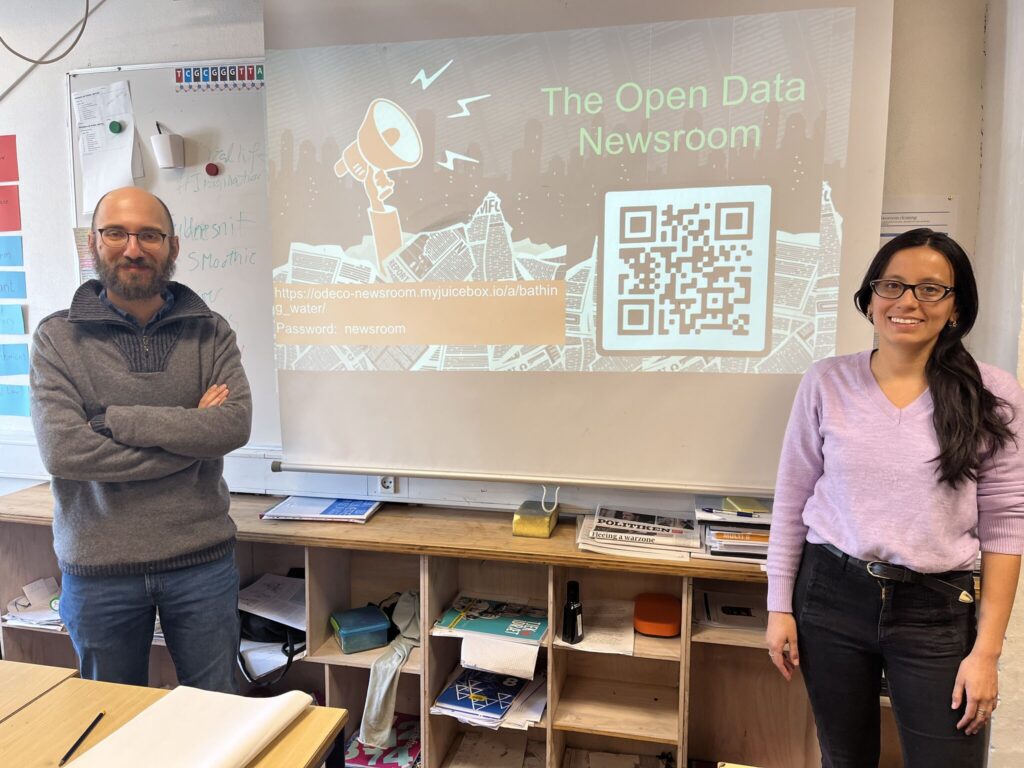Over an online coffee break, two ESRs started talking about how to collaborate, and how their research topics could intertwine. How are Open Data in schools and Data journalism connected?
Alejandra: From my research, I have found that the best way to learn Open Data competencies is by creating an authentic learning experience which can be crafted with games elements.
George: I am researching the practices and skills of data journalists. Why don’t we make the kids take the role of journalists?
Alejandra: Let’s do it. We can test it in Danish schools
After this initial conversation, a lot of calls and meetings, Alejandra and George crafted a game where the children could engage with an authentic data journalistic practice and solve a mystery to save their city. They created a narrative about teenagers in a city suffering from a mysterious disease. Open Data on water quality gave them the idea of a disease evolving over the years in different locations in Denmark and infecting the children when they were just babies.
Everything was looking nice, but still, Alejandra and George had to think about how the students would engage with this story in the classroom. They invented the imaginary “Data Journalists Hackers” network.
The chief editor of the “Data Journalists Hackers”, an international network of data journalists, invites data journalists in a local newspaper to analyze several mysterious events occurring over the past two weeks. The incidents are creating concern and fear in the citizens.
As the clever teenagers solved the mystery quite easily, George and Alejandra had to make the game harder. The story was evolving and to improve the outcome of the experiments Alejandra and George added more datasets of mysterious cases in the city connected with the water quality.
The “Data Journalists Hackers” has identified 4 cases occurring and has collected some information and open datasets. However, they need the help of local data journalists to dive deep into the cases, solve the mystery and present the truth to the citizens.
Case 1: Over the past two weeks, teenagers have been suddenly appearing at schools and hospitals with strange marks on their skin, mysteriously accompanied by high fever and hyperactivity.
Case 2: Over the past two weeks, fishermen have found mysterious contaminated fishes in different local lakes. At the beginning, they did not recognize them, as the fishes do not present strongly visible changes.
Case 3: Two weeks ago, a well-known influencer uploaded a captivating video of himself hiking in an atypical forest with peculiar occurrences and mysterious phenomena. As the video went viral, more cases of atypical forests have been reported.
Case 4: Over the past two weeks, the sudden appearance of an atypical mould in playing grounds and canteens has been reported to health authorities by local schools. The mould is alarmingly spreading every day.
The game has been now tested in 3 Danish schools and 1 more is coming. Every intervention in school is a valuable experience to learn from students and teachers and make the game better and more relevant for them every time. After the interventions Alejandra and George will conclude and discuss the game as a tool for students and journalists. It could also be very relevant for other non-specialist actors in the Open Data ecosystem.

Alejandra Celis Vargas
Aalborg University Copenhagen, Denmark
George Papageorgiou
FAROSNET


